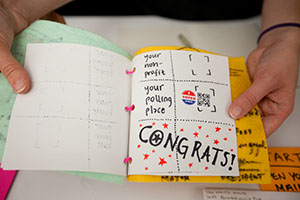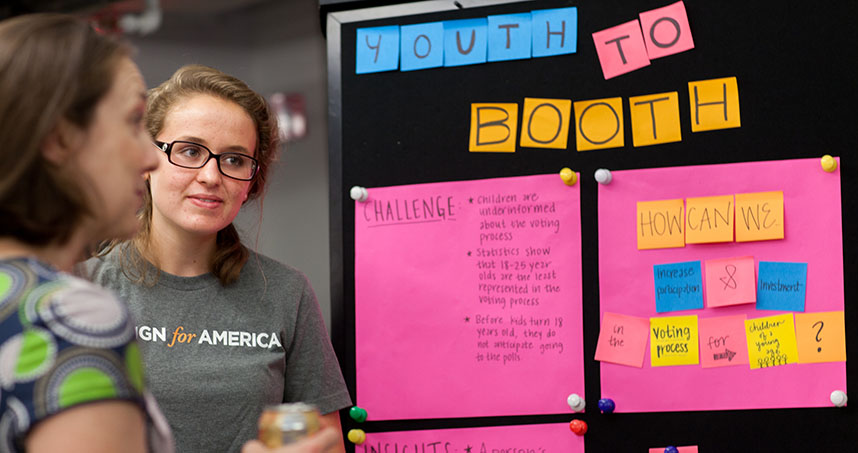Using Design to Improve the Voting Experience
More than 100 Design for America students tackled the issue at Northwestern’s annual leadership studio
Although voters aged 18 to 35 make up more than one-third of the electorate, they also have the lowest voter turnout of any age group. In order to increase participation, one Design for America (DFA) team believes voters need to be targeted as early as elementary school.
“If they are excited about the voting process earlier in life, then they will come back to vote when they are 18,” said Claire Quinlan, an undergraduate at Washington University.
Quinlan and her team’s project, called “Youth to Booth,” was one of the several designs to arise from the seventh annual DFA Leadership Studio. Held from August 11 to 15, the event welcomed 110 students from 33 universities to learn about design, social innovation, and creative leadership. With a major presidential election upon us, this year’s annual leadership studio challenged students to use human-centered design to develop solutions for improving the voting experience.
During the five-day event, students took a crash course in prototyping, interviewed community members about voting, and listened to panel discussions featuring DFA alumni, who talked about balancing school with startups, taking the leap into entrepreneurship, and post-graduation opportunities.
A grassroots, student-led network, DFA began at Northwestern seven years ago and spread across the nation to 36 universities, including Stanford, Massachusetts Institute of Technology, Cornell, and Yale. More than 1,200 students are now involved with the organization, where they assess social challenges using a human-centered design process and work collaboratively to implement solutions.
 Teams presented their voting experience solutions on Sunday at a design expo attended by business professionals, design experts, and DFA staff and alumni. Quinlan and her team presented their plans for “Youth to Booth,” which helps parents inspire civic engagement in their children by helping them collect stickers in a booklet. Each time a child learns a piece of information about government or the voting process, they collect a sticker embedded with a QR code coupon that the parent can use at local, sponsoring businesses. The booklet’s last sticker is collected at the actual voting booth.
Teams presented their voting experience solutions on Sunday at a design expo attended by business professionals, design experts, and DFA staff and alumni. Quinlan and her team presented their plans for “Youth to Booth,” which helps parents inspire civic engagement in their children by helping them collect stickers in a booklet. Each time a child learns a piece of information about government or the voting process, they collect a sticker embedded with a QR code coupon that the parent can use at local, sponsoring businesses. The booklet’s last sticker is collected at the actual voting booth.
“There is a separate kids’ booth, so they can vote alongside their parents,” said Christine Junod, an undergraduate from Virginia Tech. “But instead of voting for politicians, they vote for something that affects their lives, such as who they want as a guest speaker at the library.”
Other DFA projects to help improve the voting process included an app to simplify the voter registration process, a community action network to help spread knowledge about elections and candidates at a grassroots level, an app to help voters learn about their districts to prepare for local elections, and a community conversation table to inspire civic discussions.
Schools that participated in this year’s leadership studio were:
- Northwestern
- Babson/Olin/Wellesley
- Barnard/Columbia
- Case Western
- Cornell
- University of Colorado, Boulder
- Duke
- Johns Hopkins
- Michigan State
- MIT
- Notre Dame
- NYU
- Purdue
- Rensselaer
- Rice
- RISD/Brown
- Stanford
- UC Davis
- UC San Diego
- University of Cincinnati
- University of Illinois, Urbana-Champaign
- University of Maryland
- University of North Carolina, Chapel Hill
- University of Oklahoma
- University of Oregon
- Penn
- USC
- University of Texas, Austin
- Tulane
- San Jose State
- Virginia Tech
- Washington University
- Yale
